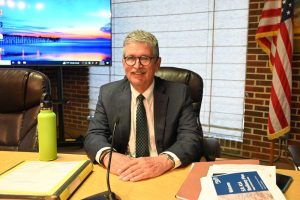
To include your event in the Briefing and Live Calendar, please fill out this form.
Weather: Showers and thunderstorms. Some thunderstorms may produce gusty winds. Locally heavy rainfall possible. Highs in the upper 80s. Southwest winds 15 to 20 mph with gusts up to 30 mph. Chance of rain 80 percent. Wednesday Night: Partly cloudy with showers and thunderstorms likely in the evening, then mostly clear with a slight chance of showers and thunderstorms after midnight. Some thunderstorms may produce gusty winds in the evening. Lows in the upper 60s. Chance of rain 70 percent.
See the daily weather briefing from the National Weather Service in Jacksonville here. See the drought conditions here. (What is the Keetch-Byram drought index?). Check today’s tides in Flagler Beach here. Check tropical cyclone activity here, and even more details here.
Today at a Glance:
The Flagler County Contractor Review Board meets at 5 p.m. at the Government Services Building, 1769 East Moody Boulevard, Bunnell. Staff liaison is Bo Snowden, Chief Building Official, who may be reached at (386) 313-4027. For agendas and details go here.
Flagler County’s Technical Review Committee Meeting at 9 a.m., first floor Conference Room, at the Government Services Building, 1769 East Moody Boulevard, Bunnell. The Technical Review Committee (TRC) is a quality control committee that provides technical review of project plans. Staff Liaison is Gina Lemon, 386-313-4067.
Flagler Tiger Bay Club Guest Speaker: County Attorney Al Hadeed. Hadeed has been principally involved in the various projects and initiatives to repair and protect Flagler County’s coastline while aiding other local governments in their similar pursuits. He serves on the Board of Directors of the Florida Association of County Attorneys and Chairs its Finance and Tax Committee. He has frequently lectured on such topics as growth management, greenway corridor development, scenic highway protection, historic preservation, ethics, and land use law. He has served on a variety of boards and associations related to these topic areas, either as a member or as counsel.
Separation Chat, Open Discussion: The Atlantic Chapter of Americans United for the Separation of Church and State hosts an open, freewheeling discussion on the topic here in our community, around Florida and throughout the United States, noon to 1 p.m. at its new location, Pine Lakes Golf Club Clubhouse Pub & Grillroom (no purchase is necessary), 400 Pine Lakes Pkwy, Palm Coast (0.7 miles from Belle Terre Parkway). Call (386) 445-0852 for best directions. All are welcome! Everyone’s voice is important. For further information email [email protected] or call Merrill at 804-914-4460.
The Circle of Light Course in Miracles study group meets at a private residence in Palm Coast every Wednesday at 1:20 PM. There is a $2 love donation that goes to the store for the use of their room. If you have your own book, please bring it. All students of the Course are welcome. There is also an introductory group at 1:00 PM. The group is facilitated by Aynne McAvoy, who can be reached at [email protected] for location and information.
Weekly Chess Club for Teens, Ages 9-18, at the Flagler County Public Library: Do you enjoy Chess, trying out new moves, or even like some friendly competition? Come visit the Flagler County Public Library at the Teen Spot every Wednesday from 4 to 5 p.m. for Chess Club. Everyone is welcome, for beginners who want to learn how to play all the way to advanced players. For more information contact the Youth Service department 386-446-6763 ext. 3714 or email us at [email protected]
Regrettably: I discovered Alice Munro late, as in just a few years ago, though my good old friend and second mother Elizabeth, who as of today has surpassed Munro’s age as she still plays her keyboards–a grand piano and a harpsichord–at her Chapel Hill home, gifted me a Munro collection maybe 30 years ago. I don’t know why I never cracked it then. A crack in my head must not have yet healed. I started reading Dance of the Happy Shades a few years ago, and felt as if I was reading a Chekhov without the early falters and unseriousness of Chekhov. Every story a gem, every story a succession of surgical insights in a style seemingly so spare and simple that it’s easy to miss how she’s walloping you and turning you upside down, with lines so recognizably current from places as ordinary as a city council well: “it did not matter much what they said as long as they were full of self-assertion and anger. That was their strength, proof of their adulthood, of themselves and their seriousness. The spirit of anger rose among them, bearing up their young voices, sweeping them together as on a flood of intoxication, and they admired each other in this new behaviour as property-owners as people admire each other for being drunk.” Or this: ” “Oh, wasn’t it strange, how in your imagination, when you stood up for something, your voice rang, people started, abashed; but in real life they all smiled in rather a special way and you saw that what you had really done was serve yourself up as a conversational delight for the next coffee party.” She had her detractors. J. Bottum wrote in the Wall Street Journal in 1999 that she has “a prose so fine it can’t lift anything heavier than a small cup of tea.” But he also wrote books like The Decline of the Novel, which should make anyone suspicious about his judgment (what novel? The American? The French? The Subcontinent?) She was once asked what impact she thought her stories had on readers, women especially. “Oh, well, I want my stories to move people, I don’t care if they are men or women or children,” she answered, in remarks picked up by the Nobel organization. “I want my stories to be something about life that causes people to say, not, oh, isn’t that the truth, but to feel some kind of reward from the writing, and that doesn’t mean that it has to be a happy ending or anything, but just that everything the story tells moves the reader in such a way that you feel you are a different person when you finish.” See below.
—P.T.
View this profile on Instagram
![]()
The Live Calendar is a compendium of local and regional political, civic and cultural events. You can input your own calendar events directly onto the site as you wish them to appear (pending approval of course). To include your event in the Live Calendar, please fill out this form.
January 2026
Free For All Fridays With Host David Ayres on WNZF
Friday Blue Forum
‘Lady Day at Emerson’s Bar and Grill,’ the Billie Holiday Story, at City Rep Theatre
Flagler Beach Farmers Market
Coffee With Flagler Beach Commission Chair Scott Spradley
Grace Community Food Pantry on Education Way
Second Saturday Plant Sale at Washington Oaks Gardens State Park
American Association of University Women (AAUW) Meeting
‘Lady Day at Emerson’s Bar and Grill,’ the Billie Holiday Story, at City Rep Theatre
For the full calendar, go here.

The new, white and shining houses, set side by side in long rows in the wound of the earth. She always thought of them as white houses, though of course they were not entirely white. They were stucco and siding, and only the stucco was white; the siding was painted in shades of blue, pink, green and yellow, all fresh and vivid colours. Last year, just at this time, in March, the bulldozers had come in to clear away the brush and second-growth and great trees of the mountain forest; in a little while the houses were going up among the boulders, the huge torn stumps, the unimaginable upheavals of that earth. The houses were frail at first, skeletons of new wood standing up in the dusk of the cold spring days. But the roofs went on, black and green, blue and red, and the stucco, the siding; the windows were put in, and plastered with signs that said, Murry’s Glass, French’s Hardwood Floors; it could be seen that the houses were real. People who would live in them came out and tramped around in the mud on Sundays. They were for people like Mary and her husband and their child, with not much money but expectations of more; Garden Place was already put down, in the minds of people who understood addresses, as less luxurious than Pine Hills but more desirable than Wellington Park. The bathrooms were beautiful, with three-part mirrors, ceramic tile, and coloured plumbing. The cupboards in the kitchen were light birch or mahogany, and there were copper lighting fixtures there and in the dinin g ells. Brick planters, matching the fireplaces, separated the living rooms and halls. The rooms were all large and light and the basements dry, and all this soundness and excellence seemed to be clearly, proudly indicated on the face of each house–those ingenuously similar houses that looked calmly out at each other, all the way down the street.
–From Alice Munro’s “The Shining Houses,” in Dance of the Happy Shades and Other Stories (1968).





































Laurel says
A political cartoon that actually made me laugh! Another thing that made me laugh was Trump’s ass sucks who showed up in New York all wearing the Trump uniform. OMG! These guys do not even have the capacity to be embarrassed! Just pucker up and hope to be VP. Damn! I’m embarrassed for them. Wow, Mike Johnson stated he was a lawyer and then proceeded to claim the trial was a political sham. Is he lying or is he that stupid? Oh, by the way, thanks Democrats for saving his ass. Next time, let him go. The Republican Party keeps sinking to new lows no one ever fathomed before.
That’s not funny, that’s sad.
Ray W. says
Another day, another epiphany!
While randomly reading about solar power panels, I came across a February 29, 2024, Oxford University Press publication about vertically installed bifacial photovoltaic (BiPV) cells. I had read about ground reflected sunlight being captured by bi-facial (two-sided) panels before, but I didn’t know that the two-sided panels had been around since 1983. I commonly thought that solar power panels were one sided. I knew that residential solar panels were one-sided. I knew that bi-facial panels cost more to manufacture, but I still don’t know how much more. I figured that the reduced efficiencies of ground reflected sunlight simply made the two-sided panels too expensive to install when compared to one-sided panels.
Nearly all solar panels in use today are considered “horizontal”, because the nominally most efficient installation angle is between 20-35 degrees depending on how far north the application. Key West might be 35 degrees and Boston 20 degrees. Normal applications call for a southern orientation, with maximum efficiency occurring some two hours before noon to two hours after noon. Solar farms that utility companies build can set the angle at the theoretical maximum, and ensure that the panels directly face the sun, but residential applications are impacted by the pitch of the roof and the orientation of the house. Utility companies can set two-sided panels higher off the ground to take advantage of the ground reflected sunlight. Some estimates have two-sided solar panels capturing as much as 15% more energy from the ground-reflected sunlight, but efficiencies vary on cloudy days or on days with snowpack reflecting more light. Residential applications have the panels mounted close to the roof, with no need for two-sided panels.
A drawback of any horizontal solar project is that peak power output occurs around noontime, which is when power demands are relatively low. Peak demand occurs in the early morning and again in the evening. Families are gearing up or winding down their day. Critics like to point out that with peak demand in the morning and evening and peak power at or around noon, solar batteries are needed to store excess power when available and discharge the stored power when needed, adding to the expense.
The Oxford University researchers asked what would happen if one installed residential two-sided panels vertically on an east/west orientation? They installed seven horizontal panels on one part of a roof. They installed on a different location on the same roof seven vertical panels. The horizontal panels faced south at a 27-degree angle. The vertical ones on an east/west axis. They compared notes for two years.
One immediate positive was that vertical panels self-clean. Therefore, homeowners don’t have to climb on their roofs to clean them in order to maintain efficiency. A negative was that vertically installed panels require sturdy mounting brackets to account for greater wind stresses. Overall production per panel differed depending on the month, but some months saw vertical panels producing as much as 100% more power than did the horizontal panels. And the vertical panels produced peak power in the morning and evening, when demand is highest. Power dips around noontime because the sun is directly overhead the vertical panels, just when demand dips. Importantly, since vertical panels take up less space, more panels can be installed on the same square footage of a residential roof, yielding even greater power outputs. This is called the “ground coverage ratio.”
Think about this, please! Solar panels do not have to be mounted on a residential roof! They can be installed as fences, depending on trees and shrubbery blocking light. But under the right conditions, vertical panels can work at ground level in the average American subdivision.
I looked further, this time to articles about commercial applications. Researchers at Leipzig University published their own study two years ago, using vertically installed utility-grade two-sided panels. They also reported greater efficiencies per day per panel when compared to two-sided horizontal panels. Importantly, since vertically installed panels take less ground space, farmers can still grow crops on a vertical solar farm. Tractors can run between the rows of solar panels. Since the panels act as windbreaks and since they absorb sunlight instead of the light absorbing into or reflecting off the ground, crops that benefit from shade during the day can be grown, and overall heat at ground level is reduced. The utility-grade vertical panels also saw power levels drop at mid-day, but they too saw greater morning and evening power outputs when compared to horizontal panels.
Imagine a Florida farmer who grows strawberries, potatoes, cabbage, lettuce, or other low-height crops, as opposed to corn. She can grow the same crops and reap the benefits to be gained from a long-term lease to a power company. Imagine a midwestern farmer who normally grows corn. He can simply grow soybeans instead and still reap the financial reward a long-term lease to a solar company would bring. Modern GPS-guided tractors should virtually eliminate collisions with panels. Even without GPS, an experienced tractor operator should have little difficulty negotiating panels. After all, they know how to drive a tractor down a row of growing plants without running over the crop. Yes, irrigation issues might require changes in the way farmers water their crops, but farmers have been improving farming methods for millennia. If anyone can adapt to changing conditions, it is a farmer who lacks hail insurance.
Nietzsche wrote: “And those who were seen dancing were thought to be insane by those who could not hear the music.”
Solar power is the future. It is already the cheapest form of electrical generation out there. Those who oppose solar power simply cannot hear the music. If vertical panel solar farms can reduce the loss of arable land caused by horizontal solar farms, allowing farmers to still grow crops; if vertical farms produce more power per panel over the same acreage; if the 35-year average cost of building and operating a solar farm drops with the installation of vertical panels; then those who oppose solar energy are simply spitting into the wind.
Pogo says
@Ray W.
Thanks for the continuing voice of what can be.
Additionally
https://www.google.com/search?q=artificial+photosynthesis